Understanding Staurolite: Characteristics and Significance
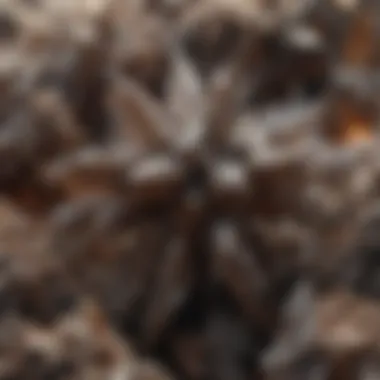
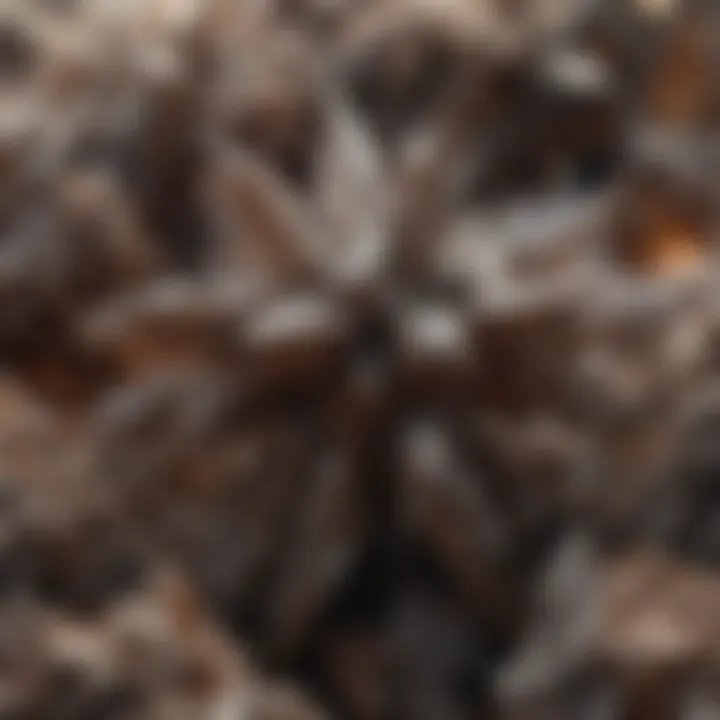
Intro
Staurolite, that remarkable mineral with its intriguing cross-shaped crystals, draws interest from a wide array of enthusiasts—geologists, collectors, and those who dabble in metaphysical practices. This article aims to weave together the many threads of staurolite's narrative, illuminating its origins, properties, and applications. Each section is crafted to enrich your appreciation of this visually striking mineral.
Gemstone Overview
Definition and Origins
Staurolite is a silicate mineral composed primarily of iron, aluminum, and silicon. Typically exhibiting a distinctive cross shape due to its twinned crystal structure, it forms under high temperatures and pressures in metamorphic rocks. Common locations for staurolite deposits include areas like the southeastern United States, especially in regions like Georgia and North Carolina, as well as parts of Europe. Its formation is often linked to the metamorphism of sedimentary rocks, which subjects them to intense geological processes.
Historical Significance
Historically, staurolite has not only captivated scientists but has also held cultural significance. For Native American tribes, for example, these crystals were sometimes seen as gifts from the spirits. Additionally, they've found a place in various legends; it has been said that the cross shape symbolizes a form of divine protection. This historical backdrop enhances the mineral’s allure, appealing to both scholars and collectors.
Gemstone Properties
Hardness and Durability
When it comes to hardness, staurolite ranks between 7 and 7.5 on the Mohs scale, making it quite durable for a gemstone. This means it can withstand wear and tear, which is beneficial for jewelry applications. However, jewelers often recommend avoiding harsh chemicals or ultrasonic cleaners, as these can damage its surface over time.
Color and Clarity
In terms of color, staurolite can present a range from a deep brown to a lighter yellow-brown. Some crystals may appear almost black under certain lighting conditions, adding to their mystique. As for clarity, staurolite typically exhibits a level of transparency that can vary but usually leans towards opaque due to inclusions.
"Staurolite's unique cross shape and robust nature not only make it a geological wonder but also a sought-after gemstone among collectors."
The appeal does not end here; when facetting staurolite for jewelry, its natural colors can be enhanced, leading to stunning pieces that are sure to catch the eye.
In diving into the multifaceted world of staurolite, one finds not just a mineral but a storied component of the Earth’s geology and a cherished gem among those who value nature's artistry.
Prelims to Staurolite
Understanding staurolite is fundamental for anyone interested in geology or mineralogy. This unique mineral, with its striking cross-shaped crystals, serves as both a geological benchmark and a collector's gem. In this chapter, we will delve into the essence of staurolite; its definition, characteristics, and why it matters in both academic research and practical applications.
Definition and Overview
Staurolite is a silicate mineral that primarily consists of iron and aluminum, belonging to the nesosilicate group. It has garnered attention not only due to its distinctive morphology but also because of its role in metamorphic rock formation. The name "staurolite" derives from the Greek word 'stauros,' meaning cross, which is aptly applicable since the crystals often form in a cross-like structure. These crystals can vary in color, generally appearing as shades of brown, red, or green, giving them a unique aesthetic appeal in gemstones.
The typical crystal structure is prismatic, and they often occur in pseudo-hexagonal forms. Staurolite’s importance extends beyond its beautiful appearance; it acts as a telltale sign for specific geological conditions that indicate the presence of metamorphic processes. Understanding its properties provides significant insights into the environmental conditions under which it formed. As staurolite can be found in regional metamorphic rocks, such as schist and gneiss, it aids geologists in piecing together the puzzle of Earth’s geological history.
Historical Context
The historical significance of staurolite cannot be overstated. First noted by mineralogists in the 18th century, its discovery contributed to early geological mapping and understanding of metamorphic processes. Explorers and miners alike have long regarded staurolite as a vital mineral. Stories abound about how this mineral was used in the past as a talisman, believed to inspire courage and mental clarity, reflecting the period's spiritual connection to nature.
During the 19th century, it caught the eye of gem enthusiasts who began to recognize its potential in the jewelry industry. The narrative of staurolite is intricately tied to the cultural practices that surrounded it, often embodying the profound relationship humans have with the natural world. These threads of history illuminate staurolite’s journey from a geologic marker to its place in metaphysical practices and commercial uses today.
By exploring the depth of its origin and its perceived value, we can appreciate not just the mineral itself but the vast human experience shaped by it throughout the ages.
Geological Formation of Staurolite
The geological formation of staurolite is a fascinating topic that sheds light on the mineral’s characteristics, origins, and environment of formation. This aspect effectively links the properties of staurolite with its occurrence, revealing how geological processes shape the materials we find within the Earth. Understanding this formation not only enriches our knowledge but also helps develop an appreciation for the intricate processes that occur over thousands to millions of years. Collectors and enthusiasts are particularly drawn to the unique formation conditions that create the beautiful, cross-shaped crystals which are synonymous with staurolite.
Origin and Occurrence
Staurolite is primarily found in metamorphic rocks, particularly those that have undergone the rigorous pressure and heat associated with regional metamorphism. This mineral often forms in schist and gneiss where its distinctive crystals develop.
- Key Locations: The most notable deposits of staurolite occur in regions like the eastern United States, specifically in North Carolina and Virginia, and various parts of Europe.
- Formation Process: Staurolite develops under specific conditions where its chemical constituents—primarily aluminum, iron, and silica—combine at high temperatures and pressures. This process is part of what is known as metamorphic grade, where increasing heat and pressure lead to the crystallization of the material.
The presence of staurolite in these regions reflects not only geological history but also the landscape. Often, it can be found surrounding other minerals, such as garnet and biotite, showcasing its relationship within the mineral community.
Formation Conditions
The conditions conducive to the formation of staurolite are unique, demanding a careful balance of temperature, pressure, and chemical composition. Understanding these conditions provides insights into how staurolite achieves its distinct properties.
- Temperature and Pressure Parameters: Staurolite typically forms at temperatures ranging from 400°C to 600°C and at pressures of 4 to 6 kbar. These settings are common in mountainous areas where tectonic activity has extensively impacted the geology.
- Metamorphic Environment: The process begins with an original rock, usually shale or granite, being subjected to metamorphic conditions. Over time, and with the application of immense heat and pressure, the minerals present transform into staurolite, integrating itself with the existing matrix of minerals.
- Chemical Environment: The availability of water and other fluids during metamorphism plays a vital role in staurolite’s formation. Water acts as a catalyst, facilitating the necessary chemical reactions that lead to crystallization.
Through careful examination of these formation conditions, enthusiasts can better appreciate how staurolite was forged from its parent rocks, and why it presents as the intriguing mineral that it is today.
Physical Characteristics of Staurolite
Understanding the physical characteristics of staurolite is crucial for both enthusiasts and researchers alike. These features highlight the mineral's unique qualities and distinguish it in the vast realm of gemstones and geological specimens. Knowing the physical makeup helps in identification, valuation, and even in determining its metaphysical properties.
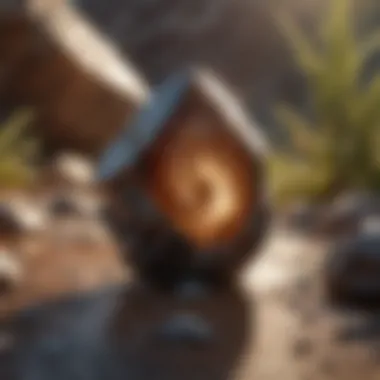
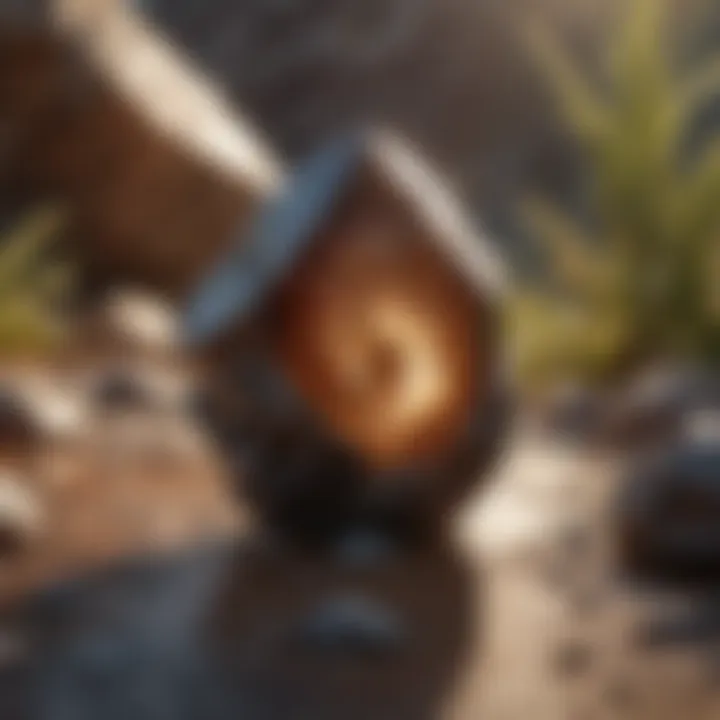
Crystal Structure
Staurolite is primarily known for its unique cruciform (cross-shaped) crystal formation. It belongs to the orthorhombic crystal system, where the arrangement of atoms tends to favor distinct shapes. Typically, the crystals form in a twinned arrangement, leading to the iconic cross shape that many mineral collectors find appealing. This twinning is not merely for show; it results from specific geological conditions during crystal growth, usually associated with high-pressure environments.
- Importance of Twinning: The formation process includes intersecting twins, which can result in crystals that are elongated or flattened. This characteristic can make staurolite particularly sought after for collectors.
- Practical Implications: When assessing the crystal structure of staurolite, one may also evaluate its crystal habit—whether it appears as short prismatic or more tabular forms. Such variations can indicate the environmental conditions present during formation.
Color and Appearance
The color of staurolite is another defining feature. The mineral typically exhibits a range of colors, from amber and brown to a rich reddish hue. This variation can be attributed to the presence of iron and other trace elements within its structure. The luster of staurolite is often described as vitreous, meaning it reflects light much like glass, giving it an appealing shine when polished.
Some notable aspects of its appearance include:
- Transparency: While some specimens can be transparent, most have a translucent quality, adding depth to their visual appeal.
- Surface Texture: Staurolite can possess a somewhat rough texture due to the growth conditions it endures. This ruggedness contributes to the charm of raw specimens often sought after in the collection.
Ultimately, the color and appearance of staurolite can be greatly impactful for value assessment in the gemstone market.
Hardness and Durability
In terms of hardness, staurolite ranks between 7 and 7.5 on the Mohs scale, making it a relatively durable gemstone. This level of hardness indicates that staurolite can withstand scratching from common materials, such as glass and metals, but may be vulnerable to more potent abrasives.
The durability of staurolite not only makes it suitable for jewelry but underscores its resilience in natural settings. Some key points to remember include:
- Wearability: Although staurolite is tough, it's important to remember that any gemstone, particularly one with intricate crystal formations like this, should be cared for to maintain its beauty.
- Heat Sensitivity: While it can tolerate moderate heat, sudden temperature changes might cause fractures. Being aware of such limitations is essential for anyone looking to incorporate staurolite into wearable art.
"The physical characteristics of staurolite render it not only visually captivating but also resilient in both natural and crafted forms."
In summary, the physical characteristics of staurolite extend beyond mere aesthetics. Its unique crystal structure, varied color palette, and notable durability converge to make this mineral a prized possession for both geological study and aesthetic enjoyment. This deeper understanding of staurolite’s physical attributes ultimately empowers enthusiasts and collectors to appreciate it on multiple levels.
Chemical Properties of Staurolite
Understanding the chemical properties of staurolite is crucial for anyone delving into the intricate world of minerals. These properties dictate not only how staurolite interacts with its environment but also its applications in diverse fields from geology to metaphysical practices. In essence, diving into the chemical aspects reveals the very fabric of what makes staurolite exceptional. Let's break it down further.
Chemical Composition
Staurolite is largely composed of several key elements. The primary formula can be expressed as [ (Fe, Mg)2Al9Si4O22(OH)2 ]. This indicates a rich blend of iron, magnesium, and aluminum—elements that significantly influence staurolite's properties. The presence of silica and hydroxyl groups lends it structural integrity, while iron contributes to its characteristic colorings. For instance, the formula showcases that varying amounts of iron and magnesium can lead to different color variations in crystals.
Key Elements in Staurolite:
- Iron (Fe): Contributes to the earthy brown and dark colors.
- Magnesium (Mg): Affects the mineral's hardness and appearance.
- Aluminum (Al): Strengthens the crystal lattice, making it relatively durable.
- Silica (Si): Aids in the crystal formation process.
- Hydroxyl (OH): Enhances stability under certain environmental conditions.
The precise arrangement of these elements leads to the unique crystal habit that staurolite displays. As it crystallizes under specific geological conditions, the resulting structure reflects its raw chemical nature, making it immensely valuable for collectors.
Common Variants
Within the realm of staurolite, it's important to recognize that variations exist, largely influenced by the elemental composition. These variants can exhibit subtle differences in color, clarity, and even physical properties. For instance, some staurolite may appear as more translucent, while others are opaque, creating a range of visual appeal that underscores its desirability.
Notable Variants of Staurolite:
- Iron-rich Staurolite: Often darker and more opaque, admired for a rugged look.
- Magnesium-rich Staurolite: This may be lighter in color, sometimes exhibiting a more translucent character.
- Clear Staurolite: Rare and sought after, providing a unique visual experience that allows observation of internal structures.
Each variant holds distinct implications for collectors, jewelry designers, and even metaphysical practitioners, as they can associate different meanings and uses with the variants.
"The interplay of chemistry and geology reveals that every piece of staurolite tells a story of its formation and existence."
As we take a deeper dive into staurolite's chemical properties, it becomes evident that these characteristics not only define the mineral's identity but also open doors to further exploration in fields that appreciate the nuances of nature's artistry.
Metaphysical and Healing Properties
The metaphysical and healing properties of staurolite hold significant interest for many gemstone enthusiasts and practitioners alike. This mineral is often believed to possess unique energies that can enhance spiritual growth and emotional stability. Understanding these properties not only provides insight into the mineral's significance but also offers a deeper perspective for individuals who integrate these beliefs into their daily lives.
Cultural Beliefs and Practices
Throughout history, many cultures have attributed various mystical and healing properties to staurolite. For instance, the ancient Greeks regarded this mineral as a stone of protection. They believed that carrying a piece of staurolite could safeguard one against harm and misfortune. This belief in protection is often linked to the unique cross-shaped crystals that this mineral exhibits. Many regard the cross shape as a powerful symbol, representing balance and harmony—qualities that resonate deeply with spiritual practitioners.
In Appalachian folklore, staurolite is sometimes referred to as the "fairy cross," believed to bring good fortune and carry the blessings of the fae. Collectors in this region often share tales of finding staurolite during significant life events, suggesting that the stones themselves may hold a personal energetic connection.
Moreover, different cultures celebrate staurolite in their rituals and healing practices. Some use the crystals during meditation to promote clarity and focus, while others might incorporate them in vision quests or shamanic journeys.
Healing Associations
Staurolite is thought to have substantial healing benefits, particularly when it comes to emotional healing and grounding. Its connection to the Earth can provide individuals with a sense of stability in times of turmoil. Many practitioners advocate that holding or wearing staurolite can help release negative energies and invite positive ones, facilitating a clearer mindset.
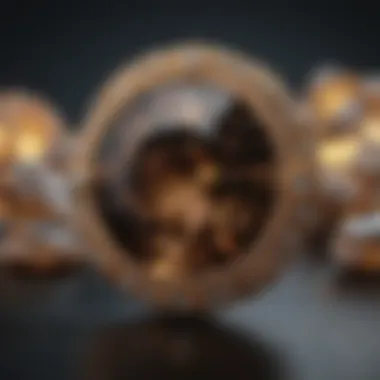
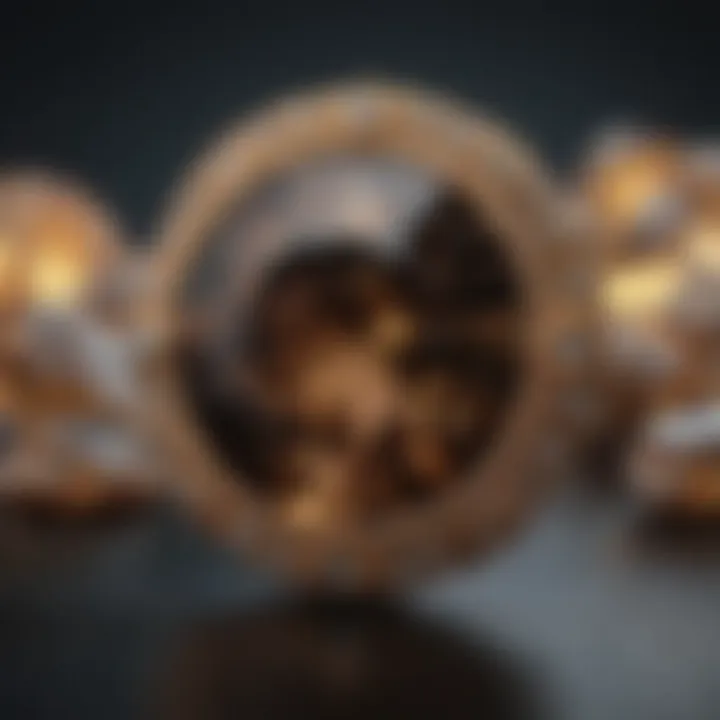
Some common healing associations include:
- Emotional Stability: Staurolite is often suggested for those dealing with stress, anxiety, or emotional trauma. Its grounding properties can foster feelings of safety and calm.
- Spiritual Growth: Users believe that staurolite aids in meditation, helping individuals deepen their spiritual practices and gain insights into their inner selves.
- Detoxification: It is said to support the body’s natural detox processes, making it a popular choice among holistic health enthusiasts.
"Staurolite acts as a bridge between the earthly realm and the spiritual one, guiding us toward transformation and healing."
Staurolite in Jewelry and Gemstone Collections
Staurolite holds a special place in the realm of jewelry and gemstone collections. Its captivating cross-shaped crystals, combined with a range of hues from brown to reddish, make it not just a geological curiosity but also an aesthetic delight. For those who appreciate the marrying of beauty and geological significance, staurolite offers a compelling reason to explore its applications in jewelry design and collection, turning ordinary pieces into extraordinary statements.
Uses in Jewelry Making
When it comes to jewelry making, staurolite may not be the first mineral that comes to mind, yet its unique characteristics give it a distinctive edge. It is often fashioned into pendants, rings, and earrings, allowing wearers to showcase its striking form. Jewelry designers who seek to blend nature's artistry with elegance find staurolite particularly attractive. The crystallography leads to stunning shapes that catch the light just right, resulting in pieces that stand out in a crowd.
- Versatility in Design: Staurolite can be cut and polished in various styles, ranging from cabochons to faceted stones. Designers often pair it with materials like silver or gold, creating a sophisticated contrast that enhances the mineral's natural appeal.
- Symbolism: Beyond aesthetics, staurolite carries symbolic weight. Many attributes it with grounding qualities. Wearing jewelry made with staurolite can evoke a sense of stability for the wearer.
- Unique Finishes: The texture of staurolite varies depending on its origin and how it is processed. Some pieces retain natural inclusions that tell a story of their geological journey, making them feel more authentic and special.
Collecting Staurolite
For collectors, staurolite represents a dynamic area of interest. Its rarity combined with its fascinating geological background makes it akin to finding a hidden gem. Collecting staurolite is not just about acquiring beautiful pieces; it’s about the adventure of sourcing and the connection to natural history.
- Source Locations: Some of the best-known deposits exist in Georgia, USA, and parts of Europe. Collectors often seek out specific locales to enhance their collections with stones from various regions, each bringing its own unique characteristics.
- Educational Aspect: Each staurolite specimen offers insights into geological processes and the environment from which it was extracted. Many collectors pride themselves on their knowledge of the mineral’s formation and its journey through time.
- Market Trends: Understanding the market for staurolite isn’t only for dealers, but for collectors as well. Tracking the changes in demand and value can provide guidance for both buying and selling, making it a strategic endeavor in the longer-term.
"In the world of gemstones, every stone tells a story, and staurolite's narrative is rich with geological and personal significance."
In summary, staurolite transcends its qualifications as a mere mineral; it emerges as a compelling subject for jewelry design and collection. Its unique properties and the emotions it evokes make it more than a decorative piece—it's a conversation starter, a piece of art, and a testament to the wonders of our Earth.
Staurolite Around the World
The exploration of staurolite transcends its scientific value, intertwining with diverse cultures and showcasing the mineral's global significance. Different regions not only host abundant deposits of staurolite, but they also weave the mineral into the very fabric of local cultures, traditions, and histories. Understanding these varied contexts enriches our appreciation of staurolite, revealing it as more than just a geological specimen but a vital link to human experience and natural beauty.
Major Locations and Deposits
Staurolite can be found in several places across the globe, each contributing to its mystique and importance. Noteworthy deposits include:
- United States: Georgia is particularly famous for its rich deposits, where staurolite often forms during the metamorphism of shale and schist. Additionally, southern Appalachian regions showcase extensive occurrences.
- Scotland: In the Scottish Highlands, staurolite appears within gneissic rocks, contributing to the geological heritage of the area. The unique cross-shaped crystals found here attract mineral collectors worldwide.
- Brazil: Staurolite from Brazil is known for its striking appearance and can often be found in association with other minerals, enhancing its appeal in the gemstone market.
- Finland: This country hosts staurolite crystals that are often larger and more defined, standing out in the Finnish geological landscape.
These deposits not only provide raw material for various applications but also serve as critical archaeological and educational sites for those studying geology and mineralogy.
Cultural Significance in Different Regions
Beyond its physical presence, staurolite carries significant cultural weight in various traditions:
- Local Myths: In certain communities, staurolite is viewed as a talisman, believed to bring good luck and protection. Stories are often shared about how these unique crystals can ward off misfortune.
- Personal Connections: For many individuals, staurolite represents a connection to the earth and natural beauty, often passed down through generations as a family heirloom. Its distinct cross shape engages emotions, symbolizing faith or resilience.
- Art and Decoration: Various cultures throughout history have used staurolite in their artworks, from carvings to jewelry, showcasing the mineral's beauty. The aesthetic appeal of staurolite has inspired artisans to incorporate it into their crafts, blending tradition with natural artistry.
"Staurolite serves as a bridge, connecting geology with rich cultural narratives that breathe life into otherwise cold mineral facts."
In summary, the significance of staurolite goes far beyond its geological properties. By contextualising it within the geographic and cultural tapestry of the world, one can truly appreciate its multifaceted roles across different societies. An understanding of where it originates and what it represents fosters a deeper respect not just for the mineral but for the rich narratives and traditions that accompany it.
Identifying Staurolite
Identifying staurolite is not just a matter of knowing what it looks like; it sits at the crossroads of geology and mineralogy, offering insights not only into the mineral itself but also into the surrounding geological environment. Staurolite, with its unique cross-shaped crystals, can often be mistaken for other minerals. Therefore, honing your identification skills is crucial for enthusiasts or collectors looking to accurately assess their specimens. This section delves into various methods that can help distinguish staurolite from its look-alikes, ensuring that you're well-equipped to appreciate this gem in all its glory.
Field Identification Techniques
When it comes to identifying staurolite in the field, keen observation and hands-on techniques are your best allies. Here are some particular methods to consider:
- Visual Inspection: Observe the characteristic cross-like shape of staurolite crystals. They usually have a clear, often brown or reddish hue but can also appear in shades of yellow or green. Look for its prismatic appearance, which sets it apart from softer minerals.
- Texture and Luster: Staurolite displays a vitreous to sub-vitreous luster. Running your fingers over the mineral can reveal its hardness, about 7 to 7.5 on the Mohs scale. If it feels rough and slightly greasy, you may be dealing with staurolite rather than its softer counterparts.
- Location, Location, Location: Knowing where you are can also guide your identification efforts. Staurolite is commonly found in metamorphic rocks such as schist and gneiss, often in regions that have gone through significant geological upheaval. If you're in a mining area or geological formation known for staurolite deposits, it’s worth taking a closer look.
- Color Responses in UV Light: When subjected to ultraviolet light, some staurolite varieties exhibit fluorescence and can reveal elements of their composition that might otherwise go unnoticed in natural lighting.
Laboratory Analysis Methods
For a more thorough identification, laboratory analysis can provide insights that field techniques cannot match. Here are some analytical methods used:
- X-ray Diffraction (XRD): This technique helps determine the mineral's crystallographic structure. Staurolite’s unique crystal system can be confirmed through its diffraction pattern, which distinguishes it from similar minerals.
- Scanning Electron Microscopy (SEM): Using SEM allows scientists to observe the surface features at a microscopic level. This is particularly useful for studying the internal structures and any inclusions that might help identify the mineral more specifically.
- Energy-Dispersive X-ray Spectroscopy (EDS): Coupled with SEM, EDS can analyze the elemental composition of staurolite. It helps to confirm the presence of iron, magnesium, and aluminum, which are crucial components of staurolite’s makeup.
"Attention to detail during identification can save you from potential mix-ups with similar minerals like kyanite or andalusite."
- Thin Section Petrography: This method involves slicing the staurolite into thin sections under polarized light. It allows geologists to observe its optical properties, providing a definitive identification and valuable insights into the mineral's history.
Identifying staurolite effectively—whether through field techniques or laboratory analyses—caters to the curiosity of collectors and enthusiasts alike. Understanding how to recognize staurolite not only enriches your knowledge but also enhances your overall appreciation for this remarkable mineral.
Care and Maintenance of Staurolite
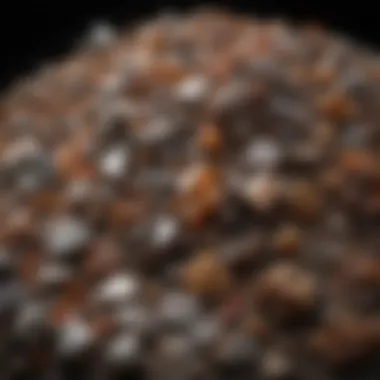
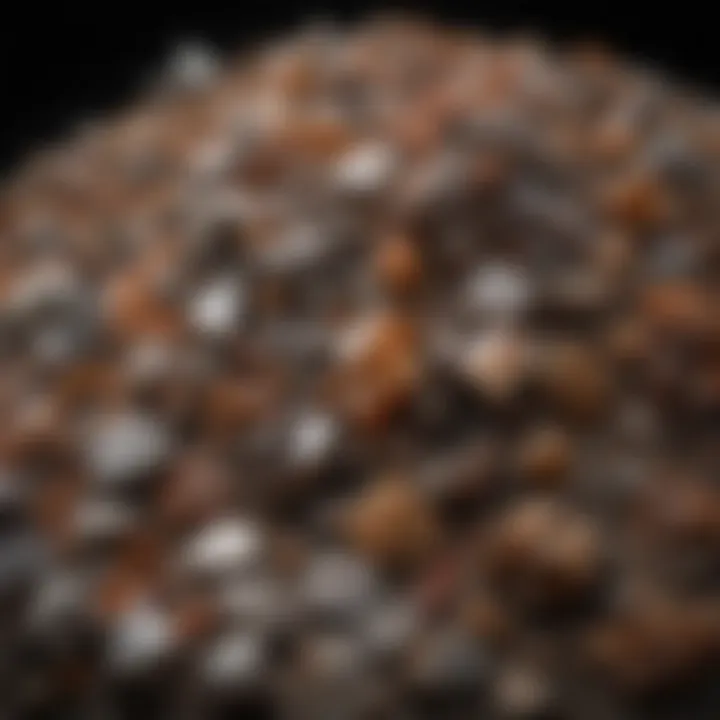
Staurolite, with its striking cross-shaped crystals and unique aesthetic appeal, certainly deserves a bit of special care to maintain its beauty and integrity. As both a geological marvel and a coveted gemstone, understanding the right methods for cleaning and proper storage is crucial. When handled with the right techniques, staurolite can be preserved for future generations to admire, whether it sits proudly in a gemstone collection or is worn as personal adornment.
Cleaning Guidelines
Keeping staurolite clean is essential not just for aesthetics but also for longevity. Regular maintenance can prevent the buildup of dirt and oils, which can dull its shine. Here are some practical suggestions to keep that sparkle:
- Gentle Cleaning Solution: Mix a mild dish soap with lukewarm water. Using a soft cloth or an old toothbrush, gently scrub away dirt without scrubbing too hard.
- Avoid Abrasives: Stay away from harsh chemicals or abrasive materials that can scratch the surface. Ammonia and bleach should definitely be avoided as they can cause significant damage to the mineral.
- Rinse and Dry: After cleaning, rinse the staurolite under lukewarm water to remove any soap residue. Pat it dry with a soft, lint-free cloth. It's a good idea not to use paper towels, which may leave scratches.
- Frequency: Depending on usage, clean staurolite pieces every few months or sooner if they look particularly dirty.
"Proper care enhances the beauty of staurolite and helps to reveal its unique inclusions and textures that tell a story of its geological journey."
These simple steps ensure that the luster of staurolite remains intact without causing any harm.
Storage Recommendations
Proper storage is just as important as cleaning when it comes to maintaining staurolite. The right environment will help protect it from scratches, chips, or any potential damage:
- Soft Pouches or Cases: Staurolite should always be stored in soft pouches or specialized gemstone cases that prevent contact with other stones, which can cause scratches. Avoid placing it with harder gemstones, like diamonds.
- Controlled Environment: Store staurolite in a temperature-regulated environment. Extreme heat or humidity can affect the structure of the stone. A dry, cool place is typically ideal.
- Avoid Direct Sunlight: Prolonged exposure to sunlight can fade the colors over time. A dark, safe space is preferable for long-term storage.
- Regular Checks: Periodically inspect stored staurolite. Ensure that pouches or cases remain dust-free and check for any signs of damage or irregularities.
Taking these storage tips into consideration will prolong the lifespan of your staurolite and maintain its striking appeal. Overall, a diligent approach to both cleaning and storage provides a way to appreciate the beauty and uniqueness of staurolite for years to come.
Debunking Myths Surrounding Staurolite
Understanding staurolite goes beyond mere appreciation of its aesthetics or geological significance; it involves recognizing and clearing up the misconceptions that often cloud knowledge about this unique mineral. Many enthusiasts, whether they are gemstone collectors, jewelry designers, or geology buffs, often fall prey to misinformation that can skew their perception of staurolite. Debunking these myths is crucial for fostering a deeper, more accurate understanding of its properties, uses, and the science behind it. Here are some common misconceptions that deserve clarifying, revealing the truth that is often overlooked.
Common Misconceptions
- Staurolite is merely a decorative stone. This belief diminishes the mineral’s geological importance. In reality, staurolite plays a significant role in understanding metamorphic processes. Its formation often signals geological transitions, thus providing critical insight into Earth’s history.
- All cross-shaped stones are staurolite. While staurolite is famed for its distinctive cross-shaped crystals, not every cross-shaped mineral belongs to this category. Other minerals can exhibit similar shapes, but they possess different structural and chemical properties.
- Staurolite is of little value in jewelry. Some view staurolite as not worthy of investment; however, its unique visual appeal and rarity can make it a desirable choice for certain jewelry styles. Gemstone enthusiasts and designers appreciate its distinctive characteristics which can elevate pieces.
- The healing properties attributed to staurolite are unfounded. Critics argue against metaphysical claims, assuming these features lack scientific backing. Nevertheless, many individuals find personal significance and subjective enrichment through these practices, suggesting that the impact of such beliefs shouldn't be dismissed outright.
- Staurolite is easy to find. Misconceptions often lead collectors to believe that staurolite is easily obtainable. The truth is, while there are locations known for them, high-quality specimens are relatively rare, making them valuable finds in the collecting community.
Scientific Explanations
When faced with myths, the scientific voice often provides the necessary clarity and education.
"Knowledge dispels confusion, revealing the true nature and wonders of the world around us."
- Geological Context: Staurolite forms under specific high-pressure and high-temperature conditions during the metamorphism of alumina-rich sediments. This emotional behavior indicates the mineral's place in geological cycles.
- Chemical Composition: Staurolite primarily consists of iron, magnesium, aluminum silicate, indicating that its properties and behavior are more complex than superficial observations might suggest. The distinct attributes depend heavily on its chemical makeup, affecting its color, structure, and even metaphysical claims made by enthusiasts.
- Symmetry and Crystal Systems: The unique cross shape of staurolite does not appear randomly. Its crystal system belongs to the monoclinic class, giving the shape its particular orientation and appearance. Without understanding this foundational aspect, one might misidentify or erroneously classify stones.
- Rarity and Value: Staurolite is not just another mineral; its rarity contributes to its market value. The specific conditions required for its formation render it less common compared to more abundant minerals. This dilutes the idea that staurolite is overly accessible, and understanding this sheds light on its desirability in both geological and commercial contexts.
Comparative Analysis
The comparative analysis of staurolite and its counterparts in the garnet group holds significant weight in unveiling the mineral's unique characteristics, uses, and the ways it stands apart. By engaging in such a comparison, enthusiasts can better appreciate not only staurolite's place within mineral classification but also its practical applications and cultural significance. This section delves into the nuances that define staurolite against other garnet minerals, bringing to light how such differences can affect their suitability for various purposes.
Staurolite vs. Other Garnet Group Minerals
When considering staurolite, it is essential to understand the context of its classification within the garnet group. Garnets are not merely a singular mineral; they are a group of related minerals that share a common crystal structure but differ in their chemical composition. Staurolite, known for its striking cross-shaped crystals, exhibits distinct attributes when compared to its garnet relatives such as almandine and pyrope.
- Crystal Structure: Staurolite's unique crystallization leads to its characteristic twinning, which results in its famous cross-shaped formations. In contrast, garnets like almandine and pyrope typically crystallize in a more straightforward isometric system, lacking the aesthetic complexity of staurolite.
- Color Variability: While staurolite usually presents as a brown to reddish-brown hue, other garnet group minerals show a wider range of colors. For example, almandine can appear deep red to purple, and pyrope is often bright red to violet. This distinction makes staurolite a favored choice for those seeking earth-toned hues in their collections or jewelry designs.
- Hardness and Durability: On the Mohs scale, staurolite sits around a 7.5, making it relatively hard and suitable for various applications. However, minerals like garnet can reach up to 8, taking the edge in durability for items like jewelry that endure everyday wear.
Comparative analysis not only highlights these differences but also informs collectors and jewelers of the best contexts to use each mineral. Understanding these properties allows for better decision-making, especially when incorporating garnets into artistic pieces or geological collections.
Physical vs. Metaphysical Properties
Exploring the interplay between the physical and metaphysical properties of staurolite leads to an enriched understanding of its value beyond just its geological makeup. While physical characteristics like color and hardness are integral, their metaphysical associations can ignite interest among gemstone enthusiasts and practitioners of alternative healing.
- Physical Properties: Staurolite exhibits an appealing luster and unique physical features that attract gem collectors. Its twinned, cross-like formations embody beauty and nature's complexity. This physical allure also leads to its use in jewelry where it not only looks stunning but holds a story through its formation.
- Metaphysical Associations: In various cultures, staurolite has been linked to spiritual cleansing and protection. Believers often feel drawn to its energies, attributing it with the power to ground them during chaotic times. This sense of connection transcends the physical and tugs at the very essence of human experience.
The distinction between these two facets provides a comprehensive narrative. It enhances the mineral's value in both the art of jewelry making and the practice of healing. A balance between appreciating staurolite's physical beauty and its energetic properties can influence how it is marketed and utilized within different realms of the gemstone community.
The relationship between a mineral’s physical characteristics and its cultural significance can profoundly affect its desirability and value in both natural and artistic forms.
Through comparative analysis, enthusiasts can engage with staurolite in a multifaceted manner — as both a striking addition to any collection and a source of metaphysical insight. This understanding permeates every level of appreciation, from geological formations to home decor.
Ending
In this article, we journeyed through the multifaceted world of staurolite, revealing its intriguing properties and applications. Understanding staurolite is not just about recognizing its physical attributes. It extends into its geological significance, its role in cultural beliefs, and its recognition within the jewelry-making community. The distinctive cross-shaped crystals of staurolite set it apart from other minerals, captivating the interests of gem collectors and geologists alike.
Summary of Key Insights
We highlighted several critical points throughout our exploration:
- Unique Characteristics: Staurolite is renown for its cruciform crystals, which often draw attention in mineral collections and jewelry.
- Geological Formation: The mineral forms under specific conditions, primarily in metamorphic rocks, making it a subject of study in earth sciences.
- Metaphysical Beliefs: In various cultures, staurolite is prized for its alleged spiritual properties, offering a bridge between natural beauty and esoteric practices.
- Practical Uses: The applications in jewelry, particularly in bespoke designs, showcase staurolite's potential for innovation in the sector.
- Global Significance: From the southern United States to regions in Europe, the variety of occurrences adds to its charm and historical significance.
These insights contribute to a greater appreciation of staurolite, painting a picture of a mineral that carries both scientific and cultural weight.
Future Directions in Staurolite Research
Looking ahead, the field of staurolite research offers several potential pathways worth exploring:
- In-depth Geological Studies: Further analysis of staurolite's formation conditions could provide better insights into metamorphic processes, potentially leading to discoveries of new staurolite deposits.
- Metaphysical Studies: As interest in alternative healing grows, examining the claimed healing properties of staurolite through scientific investigations may offer validation or debunking of long-held beliefs.
- Technological Applications: Expanding exploration into the industrial applications of staurolite could unveil practical uses, especially in material science.
- Educational Outreach: Increasing awareness about staurolite’s unique aspects through workshops and seminars can help engage a broader audience.
These domains represent just a fraction of what remains to be uncovered about this captivating mineral. By delving deeper into each element, we contribute not only to academic knowledge but to a greater public understanding of staurolite's allure and significance.



